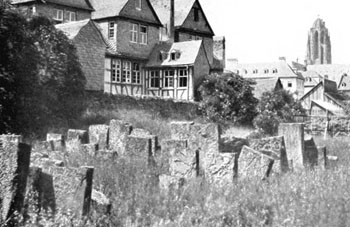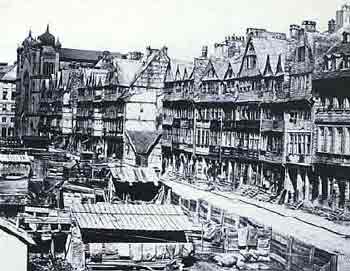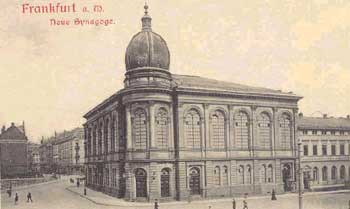Frankfurt, Germany
Frankfurt (technically Frankfurt am Main) is the largest city in the German state of Hesse and the fifth-largest city in Germany. Evidence of a Jewish community in Frankfurt can be traced back to the 12th century.
- In the Middle Ages
- Toward Modernity
- Frankfurt & the Holocaust
- The Community Today
In the Middle Ages
Evidence of a Jewish community in Frankfurt, a city
on the Main river in western Germany,
dates back to the 12th century. At that time, a small group of Jewish
merchants from Worms settled in the town, and quickly flourished and
grew wealthy. Jews had been in Frankfurt prior to this period as well,
but never as official residents – Frankfurt had long been a market
town, and Jews visited to trade there as early as the tenth century.
 Frankfurt's
Jewish cemetery, which dates to the 13th century (photograph circa 1853)
Frankfurt's
Jewish cemetery, which dates to the 13th century (photograph circa 1853) |
The
prosperity of the Frankfurt Jews, however, was short lived. The year
1241 marked the first of what would be many massacres and expulsions
of the small community. In this first attack, which was sparked by the
refusal of a Jew to convert to Christianity, more than three-quarters
of the city's 200 residents were killed. The remainder quickly fled
the city, but returned by about 1270, when Emperor Frederick II, upset
at the loss in tax-revenue from the wealthy Jewish community, ordered
strict penalties against anyone who attacked Jews. The community once
again grew rapidly, and although forced to pay crippling taxes, was
protected against any physical persecution.
The outbreak of the Black Plague in 1349, however, changed the Jews'
protected status. Jews were killed and expelled throughout Germany and
Europe, and Frankfurt was no exception. The community was completely
massacred, and many Jews chose to burn down their own houses while still
inside rather than face death from the angry mob.
 The Frankfurt Judengasse in
1890
The Frankfurt Judengasse in
1890 |
Because of their important economic role, Jews were
invited back into Frankfurt once again in 1360. Their lives in the city
however, were regulated more strictly than ever, culminating in the
forcible relocation of all the Jews of Frankfurt to a ghetto (Juddengasse)
in 1462. Originally containing just 110 inhabitants, the community developed
quickly, and consisted of 3,000 by 1610. Because the area of the ghetto
was never expanded, Jews subdivided their houses and built extra stories
to accommodate the exponential growth. The community soon became a center
of Ashkenazi Jewry –
the yeshivas in the city attracted students from all over Europe, and
the community grew very wealthy. In 1616, another pogrom came through
the community. Indeed, affluence was a necessity, for the only way the
Jewish community continued to exist in the fifteenth through seventeenth
centuries was by paying enormous tributes in exchange for protection.
In 1624, the two centuries of peace came to a crashing
halt as the ghetto was raided and plundered by a mob of artisans and
petty merchants, led by Vincent Fettmilch. The group was unhappy with
the prominent position of the Jews, and many also owed money to the
Jewish moneylenders. Unlike the previous expulsions, however, this one
ended happily for the Jewish residents of Frankfurt. The emperor outlawed
the rioters, put their leaders to death, and ceremoniously returned
the Jew to the ghetto on the twentieth day of the month of Adar, which
has been celebrated in Frankfurt ever since as "Purim Winz"
("the Purim of Vincent").
Toward
Modernity
 The "New Synagogue,"
built outside of the traditional ghetto area
The "New Synagogue,"
built outside of the traditional ghetto area |
In
1711, the ghetto burned to the ground after an accidental fire spread
out of control, but the homes and businesses were quickly rebuilt, and
the Jews returned to their isolation. The traditional unity of the Jewish
population, however, soon began to decline, as controversy over the Enlightenment and the conflict
between Rabbi Jacob Emden and Rabbi Jonathan Eybeschuetz spread throughout
Europe. The rich families that had long controlled the community saw
their influence begin to decline; these families, identifiable by the
crests hanging outside their homes, lost their influence to the maskilim,
who advocated secular education and emancipation. The only exception
was the Red Shield, or Rothschild family, which maintained its importance,
and became even more prominent in later years.
When, in 1806, Frankfurt was incorporated into Napoleon's
Confederation of the Rhine, the Jews' lot improved, at least in the
eyes of the advocates of emancipation. The spread of the ideals of the
French Revolution led to the abolition of the ghetto in 1811. Despite
setbacks in 1819 due to the "Hep
Hep riots," Jews received rights equal to those of non-Jews
in1824. Frankfurt had by now become a center of the Reform movement,
the ascendance of which led to a widening rift between the Orthodox and Reform communities. The
latter was led during much of the nineteenth century by philosopher Abraham Geiger;
the former, which accounted for only ten percent of Frankfurt's Jewish
population in 1842, was revived by Rabbi
Samson Raphael Hirsch, who founded the Orthodox "Israelitische
Religionsgesellschaft" ("Israelite Church Society")
in 1851. The community continued to grow and become wealthy; members
of the Rothschild family in particular became known for their philanthropy.
Several orthodox yeshivas were established, as was a Reform Institute
for Jewish Studies, which featured lectures by the scholar Martin
Buber.
By the 1900s, Jews in Frankfurt were extremely prosperous
and influential. They became active both in business and politics. Many
of the Jews fought for Germany in World War I.
Frankfurt
& the Holocaust
In 1933, a boycott was targeted at the Jews, and in
the subsequent years, more and more restrictions were placed on the
Jewish community. On November 10, 1938, the biggest Orthodox and Reform synagogues were burned to the ground. Many Jews emigrated from Frankfurt, and most
of those who did not were sent to the Lodz ghetto, and eventually to the Dachau and Buchenwald concentration
camps. In 1933, 30,000 Jews lived in Frankfurt; in 1945, only 602 remained.
The
Community Today
After
the war, a new community was established, consisting of Holocaust survivors
and displaced persons. In 1989, immigrants from the recently disbanded
Soviet Union increased the size of the community to about 7,000. Today,
most of the Jews live in the West End, and are self-employed, particularly
as shop-keepers and real-estate brokers. Anti-Semitism is negligible; instead, assimilation is the community's dominant social
problem. All the city's synagogues, only one of which dates to before
1938, are Orthodox.
There are few remnants of Frankfurt's Jewish community left today.
The ghetto has been gone for more than a century, but the spot on which
it stood is still accessible. Not far from the Zeil – the pedestrian
mall running through the city's center – on Bornestrasse, is the
stretch of land on which the Frankfurt Jews lived for more than 400
years. The Bornestrasse synagogue and the Rothschild home were both
destroyed, but plaques mark the spots where they stood.
The Westend synagogue, on Freiherr-vom-Stein-Strasse,
is the only Jewish building in the city with a history. The large grey
building was built early in the 1900s, and was the only synagogue to
survive Kristallnacht.
Near the synagogue is Frankfurt's Jewish community center, a huge building
adorned with large iron menorahs and stone tablets. The building features concerts, lectures and information
on all things Jewish in Frankfurt.
The Jewish museum on Untermainkai is located in a
house that once belonged to the Rothschild family, and features high-tech
resources as well as priceless artifacts, including Moritz Oppenheimer's
famous portrait of Mendelsohn and Lessing. But the most famous part of the museum is the scale-model
of the Frankfurt Juddengasse, reconstructed using the blueprints
made in 1711 after it was destroyed by fire. The intricate model includes
194 buildings.
Sources: “Frankfurt.” Encyclopedia
Britannica.
"Frankfurt." Encyclopedia
Judaica.
Mendes-Flohr, Paul, and Judah Reinharz. The
Jew in the Modern World: A Documentary History. Oxford
University Press. New York, 1995.
Tigay, Alan. The
Jewish Traveler. Jason Aronson,
Inc. Northvale, NJ, 1994. |